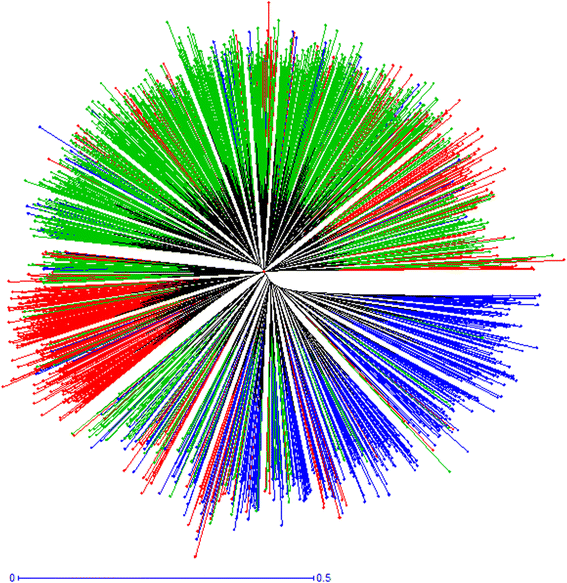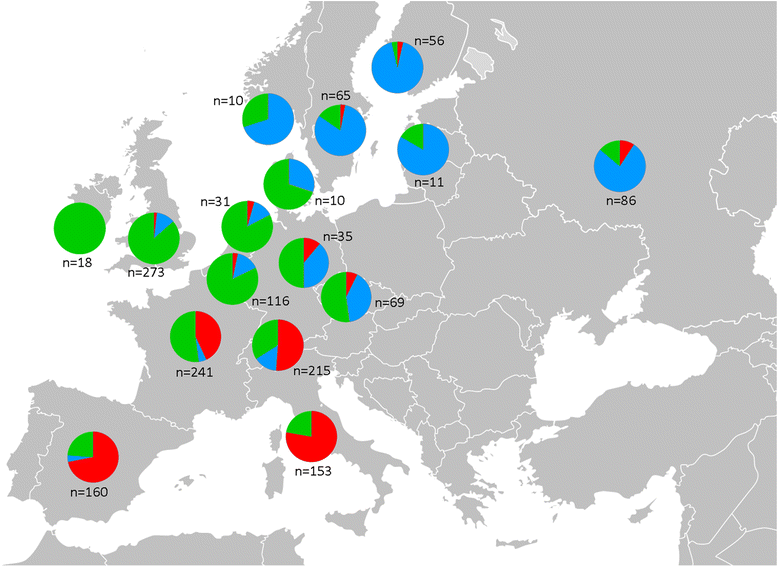Analysis of the genetic diversity and structure across a wide range of germplasm reveals prominent gene flow in apple at the European level
- PMID: 27277533
- PMCID: PMC4898379
- DOI: 10.1186/s12870-016-0818-0
Analysis of the genetic diversity and structure across a wide range of germplasm reveals prominent gene flow in apple at the European level
Abstract
Background: The amount and structure of genetic diversity in dessert apple germplasm conserved at a European level is mostly unknown, since all diversity studies conducted in Europe until now have been performed on regional or national collections. Here, we applied a common set of 16 SSR markers to genotype more than 2,400 accessions across 14 collections representing three broad European geographic regions (North + East, West and South) with the aim to analyze the extent, distribution and structure of variation in the apple genetic resources in Europe.
Results: A Bayesian model-based clustering approach showed that diversity was organized in three groups, although these were only moderately differentiated (FST = 0.031). A nested Bayesian clustering approach allowed identification of subgroups which revealed internal patterns of substructure within the groups, allowing a finer delineation of the variation into eight subgroups (FST = 0.044). The first level of stratification revealed an asymmetric division of the germplasm among the three groups, and a clear association was found with the geographical regions of origin of the cultivars. The substructure revealed clear partitioning of genetic groups among countries, but also interesting associations between subgroups and breeding purposes of recent cultivars or particular usage such as cider production. Additional parentage analyses allowed us to identify both putative parents of more than 40 old and/or local cultivars giving interesting insights in the pedigree of some emblematic cultivars.
Conclusions: The variation found at group and subgroup levels may reflect a combination of historical processes of migration/selection and adaptive factors to diverse agricultural environments that, together with genetic drift, have resulted in extensive genetic variation but limited population structure. The European dessert apple germplasm represents an important source of genetic diversity with a strong historical and patrimonial value. The present work thus constitutes a decisive step in the field of conservation genetics. Moreover, the obtained data can be used for defining a European apple core collection useful for further identification of genomic regions associated with commercially important horticultural traits in apple through genome-wide association studies.
Keywords: Differentiation; Genetic resources; Malus x domestica Borkh.; Parentage analysis; Population structure; SSR markers; Variability.
Figures




References
-
- Food and Agriculture Organization of the United Nations. FAO statistics database on the World Wide Web http://faostat.fao.org/site/567/DesktopDefault.aspx?PageID0567#ancor. Accessed 27 July 2015.
-
- Hokanson SC, Lamboy WF, Szewc-McFadden AK, McFerson JR. Microsatellite (SSR) variation in a collection of Malus (apple) species and hybrids. Euphytica. 2001;118:281–94. doi: 10.1023/A:1017591202215. - DOI
-
- Janick J, Moore JN. Fruit breeding. Volume I: tree and tropical fruits. New York: Wiley; 1996.
-
- Laurens F, Durel CE, Patocchi A, Peil A, Salvi S, Tartarini S, Velasco R, van de Weg WE. Review on apple genetics and breeding programs and presentation of a new initiative of a news European initiative to increase fruit breeding efficiency. J Fruit Sci. 2010;27:102–7.
-
- Noiton DAM, Alspach PA. Founding clones, inbreeding, coancestry, and status number of modern apple cultivars. J Am Soc Hortic Sci. 1996;121:773–82.
Publication types
MeSH terms
Substances
LinkOut - more resources
Full Text Sources
Other Literature Sources
Miscellaneous

